Title 40
PART 82 APPENDIX A
| Class 1 controlled substances | ODP |
|---|---|
| A. Group I: | |
| CFCl3-Trichlorofluoromethane (CFC-ll) | 1.0 |
| CF2 Cl2-Dichlorofifluoromethane (CFC-12) | 1.0 |
| C2 F3 Cl3-Trichlorotrifluoroethane (CFC-113) | 0.8 |
| C2 F4 Cl2-Dichlorotetrafluoroethane (CFC-114) | 1.0 |
| C2 F5 Cl-Monochloropentafluoroethane (CFC-115) | 0.6 |
| All isomers of the above chemicals | |
| B. Group II: | |
| CF2 ClBr-Bromochlorodifluoromethane (Halon-1211) | 3.0 |
| CF3 Br-Bromotrifluoromethane (Halon-1301) | 10.0 |
| C2 F4 Br2-Dibromotetrafluoroethane (Halon-2402) | 6.0 |
| All isomers of the above chemicals | |
| C. Group III: | |
| CF3 Cl-Chlorotrifluoromethane (CFC-13) | 1.0 |
| C2 FCl5-(CFC-111) | 1.0 |
| C2 F2 Cl4-(CFC-112) | 1.0 |
| C3 FCl7-(CFC-211) | 1.0 |
| C3 F2 Cl6-(CFC-212) | 1.0 |
| C3 F3 Cl5-(CFC-213) | 1.0 |
| C3 F4 Cl4-(CFC-214) | 1.0 |
| C3 F5 Cl3-(CFC-215) | 1.0 |
| C3 F6 Cl2-(CFC-216) | 1.0 |
| C3 F7 Cl-(CFC-217) | 1.0 |
| All isomers of the above chemicals | |
| D. Group IV: CCl4-Carbon Tetrachloride | 1.1 |
| E. Group V: | |
| C2 H3 Cl3-1,1,1 Trichloroethane (Methyl chloroform) | 0.1 |
| All isomers of the above chemical except 1,1,2-trichloroethane | |
| F. Group VI: CH3 Br - Bromomethane (Methyl Bromide) | 0.7 |
| G. Group VII: | |
| CHFBR2 | 1.00 |
| CHF2 Br (HBFC-2201) | 0.74 |
| CH2 FBr | 0.73 |
| C2 HFBr4 | 0.3-0.8 |
| C2 HF2 Br3 | 0.5-1.8 |
| C2 HF3 Br2 | 0.4-1.6 |
| C2 HF4 Br | 0.7-1.2 |
| C2 H2 FBr3 | 0.1-1.1 |
| C2 H2 F2 Br2 | 0.2-1.5 |
| C2 H2 F3 Br | 0.7-1.6 |
| C2 H2 FBr2 | 0.1-1.7 |
| C2 H3 F2 Br | 0.2-1.1 |
| C2 H4 FBr | 0.07-0.1 |
| C3 HFBr6 | 0.3-1.5 |
| C3 HF2 Br5 | 0.2-1.9 |
| C3 HF3 Br4 | 0.3-1.8 |
| C3 HF4 Br3 | 0.5-2.2 |
| C3 HF5 Br2 | 0.9-2.0 |
| C3 HF6 Br | 0.7-3.3 |
| C3 H2 FBR5 | 0.1-1.9 |
| C3 H2 F2 BR4 | 0.2-2.1 |
| C3 H2 F3 Br3 | 0.2-5.6 |
| C3 H2 F4 Br2 | 0.3-7.5 |
| C3 H2 F5 BR | 0.9-14 |
| C3 H3 FBR4 | 0.08-1.9 |
| C3 H3 F2 Br3 | 0.1-3.1 |
| C3 H3 F3 Br2 | 0.1-2.5 |
| C3 H3 F4 Br | 0.3-4.4 |
| C3 H4 FBr3 | 0.03-0.3 |
| C3 H4 F2 Br2 | 0.1-1.0 |
| C3 H4 F3 Br | 0.07-0.8 |
| C3 H5 FBr2 | 0.04-0.4 |
| C3 H5 F2 Br | 0.07-0.8 |
| C3 H6 FB | 0.02-0.7 |
| H. Group VIII: | |
| CH2BrCl (Chlorobromomethane 0.12 |
Appendix A to Subpart B of Part 82 - Standard for Recycle/Recover Equipment
40:21.0.1.1.1.2.1.8.13 : Appendix A
Appendix A to Subpart B of Part 82 - Standard for Recycle/Recover Equipment Standard of Purity for Use in Mobile Air-Conditioning Systems ForewordDue to the CFC's damaging effect on the ozone layer, recycle of CFC-12 (R-12) used in mobile air-conditioning systems is required to reduce system venting during normal service operations. Establishing recycle specifications for R-12 will assure that system operation with recycled R-12 will provide the same level of performance as new refrigerant.
Extensive field testing with the EPA and the auto industry indicate that reuse of R-12 removed from mobile air-conditioning systems can be considered, if the refrigerant is cleaned to a specific standard. The purpose of this standard is to establish the specific minimum levels of R-12 purity required for recycled R-12 removed from mobile automotive air-conditioning systems.
1. ScopeThis information applies to refrigerant used to service automobiles, light trucks, and other vehicles with similar CFC-12 systems. Systems used on mobile vehicles for refrigerated cargo that have hermetically sealed, rigid pipe are not covered in this document.
2. References SAE J1989, Recommended Service Procedure for the Containment of R-12 SAE J1990, Extraction and Recycle Equipment for Mobile Automotive Air-Conditioning Systems ARI Standard 700-88 3. Purity SpecificationThe refrigerant in this document shall have been directly removed from, and intended to be returned to, a mobile air-conditioning system. The contaminants in this recycled refrigerant 12 shall be limited to moisture, refrigerant oil, and noncondensable gases, which shall not exceed the following level:
3.1 Moisture: 15 ppm by weight.
3.2 Refrigerant Oil: 4000 ppm by weight.
3.3 Noncondensable Gases (air): 330 ppm by wright.
4. Refrigeration Recycle Equipment Used in Direct Mobile Air-Conditioning Service Operations Requirement4.1 The equipment shall meet SAE J1990, which covers additional moisture, acid, and filter requirements.
4.2 The equipment shall have a label indicating that it is certified to meet this document.
5. Purity Specification of Recycled R-12 Refrigerant Supplied in Containers From Other Recycle SourcesPurity specification of recycled R-12 refrigerant supplied in containers from other recycle sources, for service of mobile air-conditioning systems, shall meet ARI Standard 700-88 (Air Conditioning and Refrigeration Institute).
6. Operation of the Recycle EquipmentThis shall be done in accordance with SAE J1989.
RationaleNot applicable.
Relationship of SAE Standard to ISO StandardNot applicable.
Reference Section SAE J1989, Recommended Service Procedure for the Containment of R-12 SAE J1990, Extraction and Recycle Equipment for Mobile Automotive Air-Conditioning Systems ARI Standard 700-88 ApplicationThis information applies to refrigerant used to service automobiles, light trucks, and other vehicles with similar CFC-12 systems. Systems used on mobile vehicles for refrigerated cargo that have hermetically sealed, rigid pipe are not covered in this document.
Committee Composition Developed by the SAE Defrost and Interior Climate Controls Standards Committee W.J. Atkinson, Sun Test Engineering, Paradise Valley, AZ - Chairman J.J. Amin, Union Lake, MI H.S. Andersson, Saab Scania, Sweden P.E. Anglin, ITT Higbie Mfg. Co., Rochester, MI R.W. Bishop, GMC, Lockport, NY D. Hawks, General Motors Corporation, Pontiac, MI J.J. Hernandez, NAVISTAR, Ft. Wayne, IN H. Kaltner, Volkswagen AG, Germany, Federal Republic D.F. Last, GMC, Troy, MI D.E. Linn, Volkswagen of America, Warren, MI J.H. McCorkel, Freightliner Corp., Charlotte, NC C.J. McLachlan, Livonia, MI H.L. Miner, Climate Control Inc., Decatur, IL R.J. Niemiec, General Motors Corp., Pontiac, MI N. Novak, Chrysler Corp., Detroit, MI S. Oulouhojian, Mobile Air Conditioning Society, Upper Darby, PA J. Phillips, Air International, Australia R.H. Proctor, Murray Corp., Cockeysville, MD G. Rolling, Behr America Inc., Ft. Worth, TX C.D. Sweet, Signet Systems Inc., Harrodsburg, KY J.P. Telesz, General Motors Corp., Lockport, NY Extraction and Recycle Equipment for Mobile Automotive Air Conditioning Systems SAE Recommended Practice, SAE J1990 (1991) 1 0. ForewordDue to the CFC's damaging effect on the ozone layer, recycle of CFC-12 (R-12) used in mobile air-conditioning systems is required to replace system venting during normal service operations. Establishing recycle specifications for R-12 will provide the same level of performance as new refrigerant.
1 This standard is appropriate for equipment certified after February 1, 1992. This equipment may be marked design certified for compliance with SAE J1990 (1991). The standard for approval for equipment certified on or before February 1, 1992 is SAE J1990 (1989). This equipment may be marked design certified for compliance with SAE J1990 (1989). Both types of equipment are considered approved under the requirements of this regulation.
Extensive field testing with the EPA and the auto industry indicates that R-12 can be reused, provided that it is cleaned to specifications in SAE J1991. The purpose of this document is to establish the specific minimum equipment specification required for recycle of R-12 that has been directly removed from mobile systems for reuse in mobile automotive air-conditioning systems.
1. ScopeThe purpose of this document is to provide equipment specifications for CFC-12 (R-12) recycling equipment. This information applies to equipment used to service automobiles, light trucks, and other vehicles with similar CFC-12 air-conditioning systems. Systems used on mobile vehicles for refrigerated cargo that have hermetically sealed systems are not covered in this document. The equipment in this document is intended for use with refrigerant that has been directly removed from, and intended to be returned to, a mobile air-conditioning system. Should other revisions due to operational or technical requirements occur, this document may be amended.
2. References2.1 Applicable Documents:
2.1.1 SAE Publications - Available from SAE, 400 Commonwealth Drive, Warrendale, PA 15096-0001.
SAE J1991 - Standard of Purity for Use in Mobile Air-Conditioning Systems SAE J2196 - Service Hose for Automotive Air-Conditioning2.1.2 CGA Publications - Available from CGA, Crystal Gateway #1, Ste. 501, 1235 Jefferson Davis Hwy., Arlington, VA 22202
CGA Pamphlet S-1.1 - Pressure Relief Device Standard Part 1 - Cylinders for Compressed Gases 3. Specification and General Description3.1 The equipment must be able to extract and process CFC-12 from mobile air-conditioning systems. The equipment shall process the contaminated R-12 samples as defined in 8.4 and shall clean the refrigerant to the level as defined in SAE J1991.
3.2 The equipment shall be suitable for use in an automotive service environment and be capable of continuous operation in ambients from 10 to 49 °C.
3.3 The equipment must be certified by Underwriters Laboratories or an equivalent certifying laboratory.
3.4 The equipment shall have a label “Design Certified by (Company Name) to Meet SAE J1991”. The minimum letter size shall be bold type 3 mm in height.
4. Refrigeration Recycle Equipment Requirements4.1 Moisture and Acid - The equipment shall incorporate a desiccant package that must be replaced before saturated with moisture and whose mineral acid capacity is at least 5% by weight of total system dry desiccant.
4.1.1 The equipment shall be provided with a moisture detection device that will reliably indicate when moisture in the CFC-12 exceeds the allowable level and requires the filter/dryer replacement.
4.2 Filter - The equipment shall incorporate an in-line filter that will trap particulates of 15 µm or greater.
4.3 Noncondensable Gas.
4.3.1 The equipment shall either automatically purge noncondensables (NCGs) if the acceptable level is exceeded or incorporate a device to alert the operator that NCG level has been exceeded. NCG removal must be part of normal operation of the equipment and instructions must be provided to enable the task to be accomplished within 30 minutes.
4.3.2 Refrigerant loss from noncondensable gas purging during testing described in Section 8 shall not exceed five percent (5%) by weight of the total contaminated refrigerant removed from the test system.
4.3.3 Transfer of Recycled Refrigerant - Recycled refrigerant for recharging and transfer shall be taken from the liquid phase only.
5. Safety Requirements5.1 The equipment must comply with applicable federal, state and local requirements on equipment related to the handling of R-12 material. Safety precautions or notices related to the safe operation of the equipment shall be prominently displayed on the equipment and should also state “Caution - Should Be Operated By Qualified Personnel”.
6. Operating Instructions6.1 The equipment manufacturer must provide operating instructions, necessary maintenance procedures, and source information for replacement parts and repair.
6.2 The equipment must prominently display the manufacturer's name, address and any items that require maintenance or replacement that affect the proper operation of the equipment. Operation manuals must cover information for complete maintenance of the equipment to assure proper operation.
7. Functional Description7.1 The equipment must be capable of ensuring recovery of the R-12 from the system being service, by reducing the system pressure below atmospheric to a minimum of 102 mm of mercury.
7.2 To prevent overcharge, the equipment must be equipped to protect the tank used to store the recycled refrigerant with a shutoff device and a mechanical pressure relief valve.
7.3 Portable refillable tanks or containers used in conjunction with this equipment must meet applicable Department of Transportation (DOT) or Underwriters Laboratories (UL) Standards and be adaptable to existing refrigerant service and charging equipment.
7.4 During operation, the equipment shall provide overfill protection to assure the storage container, internal or external, liquid fill does not exceed 80% of the tank's rated volume at 21.1 °C (70 °F) per DOT standards, CFR title 49, § 173.304 and American Society of Mechanical Engineers.
7.4.1 Additional Storage Tank Requirements.
7.4.1.1 The cylinder valve shall comply with the standard for cylinder valves, UL 1769.
7.4.1.2 The pressure relief device shall comply with the Pressure Relief Device Standard Part 1 - Cylinders for Compressed Gases, CGA Pamphlet S-1.1.
7.4.1.3 The tank assembly shall be marked to indicate the first retest date, which shall be 5 years after date of manufacture. The marking shall indicate that retest must be performed every subsequent 5 years. The marking shall be in letters at least 1/4 in high.
7.5 All flexible hoses must meet SAE J2196 hose specification effective January 1, 1992.
7.6 Service hoses must have shutoff devices located within 30 cm (12 in) of the connection point to the system being serviced to minimize introduction of noncondensable gases into the recovery equipment and the release of the refrigerant when being disconnected.
7.7 The equipment must be able to separate the lubricant from the recovered refrigerant and accurately indicate the amount removed during the process, in 30 ml units. Refrigerant dissolves in lubricant sample. This creates the illusion that more lubricant has been recovered than actually has been. The equipment lubricant measuring system must take in account such dissolved refrigerant to prevent overcharging the vehicle system with lubricant. Note: Use only new lubricant to replace the amount removed during the recycle process. Used lubricant should be discarded per applicable federal, state, and local requirements.
7.8 The equipment must be capable of continuous operation in ambient of 10 to 49 °C (50 to 120 °F).
7.9 The equipment should be compatible with leak detection material that may be present in the mobile AC system.
8. TestingThis test procedure and the requirement are used for evaluation of the equipment for its ability to clean the contaminated R-12 refrigerant.
8.1 The equipment shall clean the contaminated R-12 refrigerant to the minimum purity level as defined in SAE J1991, when tested in accordance with the following conditions:
8.2 For test validation, the equipment is to be operated according to the manufacturer's instructions.
8.3 The equipment must be preconditioned with 13.6 kg (30 lb) of the standard contaminated R-12 at an ambient of 21 °C (70 °F) before starting the test cycle. Sample amounts are not to exceed 1.13 kg (2.5 lb) with sample amounts to be repeated every 5 min. The sample method fixture, defined in Fig. 1, shall be operated at 24 °C (75 °F).
8.4 Contaminated R-12 Samples.
8.4.1 Standard contaminated R-12 refrigerant shall consist of liquid R-12 with 100 ppm (by weight) moisture at 21 °C (70 °F) and 45,000 ppm (by weight) mineral oil 525 suspension nominal and 770 ppm by weight of noncondensable gases (air).
8.4.2 High moisture contaminated sample shall consist of R-12 vapor with 1,000 ppm (by weight) moisture.
8.4.3 High oil contaminated sample shall consist of R-12 with 200,000 ppm (by weight) mineral oil 525 suspension viscosity nominal.
8.5 Test Cycle.
8.5.1 After preconditioning as stated in 8.3, the test cycle is started, processing the following contaminated samples through the equipment:
8.5.1.1 3013.6 kg (30 lb) of standard contaminated R-12.
8.5.1.2 1 kg (2.2 lb) of high oil contaminated R-12.
8.5.1.3 4.5 kg (10 lb) of standard contaminated R-12.
8.5.1.4 1 kg (2.2 lb) of high moisture contaminated R-12.
8.6 Equipment Operating Ambient.
8.6.1 The R-12 is to be cleaned to the minimum purity level, as defined in SAE J1991, with the equipment operating in a stable ambient of 10, 21, and 49 °C (50, 70, and 120 °F) and processing the samples as defined in 8.5.
8.7 Sample Analysis.
8.7.1 The processed contaminated sample shall be analyzed according to the following procedure.
8.8 Quantitative Determination of Moisture.
8.8.1 The recycled liquid phase sample of CFC-12 shall be analyzed for moisture content via Karl Fischer coulometer titration or an equivalent method. The Karl Fischer apparatus is an instrument for precise determination of small amounts of water dissolved in liquid and/or gas samples.
8.8.2 In conducting the test, a weighed sample of 30 to 130 grams is vaporized directly into the Karl Fischer analyte. A coulometer titration is conducted and the results are calculated and displayed as parts per million moisture (weight).
8.9 Determination of Percent Lubricant.
8.9.1 The amount of oil in the recycled sample of CFC-12 is to be determined by gravimetric analysis.
8.9.2 Following venting of noncondensable, in accordance with the manufacturer's operating instructions, the refrigerant container shall be shaken for 5 minutes prior to extracting samples for test.
8.9.3 A weighted sample of 175 to 225 grams of liquid CFC-12 is allowed to evaporate at room temperature. The percent oil is to be calculated from the weight of the original sample and the residue remaining after the evaporation.
8.10 Noncondensable Gas.
8.10.1 The amount of noncondensable gas is to be determined by gas chromatography. A sample of vaporized refrigerant liquid shall be separated and analyzed by gas chromatography. A Porapak Q column at 130 °C and a hot wire detector may be used for analysis.
8.10.2 This test shall be conducted on recycled refrigerant (taken from the liquid phase) within 30 minutes after the proper venting of noncondensable.
8.10.3 Samples shall be shaken for 8 hours prior to retesting while at a temperature of 24 ±2.8 °C (75 ±5 °F). Known volumes of refrigerant vapor are to be injected for separation and analysis by means of gas chromatography. A Porapak Q column at 130 °C (266 °F) and a hot wire detector are to be used for the analysis.
8.10.4 This test shall be conducted at 21 and 49 °C and may be performed in conjunction with the testing defined in Section 8.6. The equipment shall process at least 13.6 kg of standard contaminated refrigerant for this test.
8.11 Sample Requirements.
8.11.1 The sample shall be tested as defined in 8.7, 8.8, 8.9, and 8.10 at ambient temperatures of 10, 21, and 49 °C (50, 70, and 120 °F) as defined in 8.6.1.
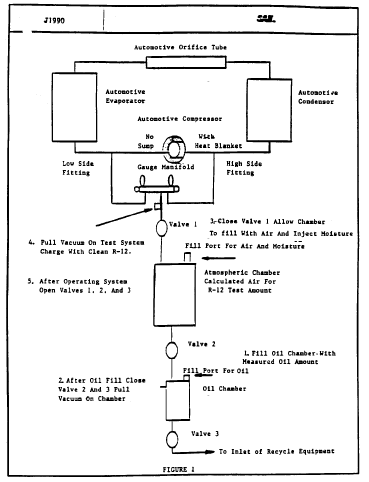 Recommended Service Procedure for the Containment of R-12 1. Scope
Recommended Service Procedure for the Containment of R-12 1. Scope
During service of mobile air-conditioning systems, containment of the refrigerant is important. This procedure provides service guidelines for technicians when repairing vehicles and operating equipment defined in SAE J1990.
2. References SAE J1990, Extraction and Recycle Equipment for Mobile Automotive Air-Conditioning Systems 3. Refrigerant Recovery Procedure3. 1 Connect the recovery unit service hoses, which shall have shutoff valves within 12 in (30 cm) of the service ends, to the vehicle air-conditioning system service ports.
3.2 Operate the recovery equipment as covered by the equipment manufacturers recommended procedure.
3.2.1 Start the recovery process and remove the refrigerant from the vehicle AC system. Operate the recovery unit until the vehicle system has been reduced from a pressure to a vacuum. With the recovery unit shut off for at least 5 min, determine that there is no refrigerant remaining in the vehicle AC system. If the vehicle system has pressure, additional recovery operation is required to remove the remaining refrigerant. Repeat the operation until the vehicle AC system vacuum level remains stable for 2 min.
3.3 Close the valves in the service lines and then remove the service lines from the vehicle system. Proceed with the repair/service. If the recovery equipment has automatic closing valves, be sure they are properly operating.
4. Service With Manifold Gage Set4.1 Service hoses must have shutoff valves in the high, low, and center service hoses within 12 in (30 cm) of the service ends. Valves must be closed prior to hose removal from the air-conditioning system. This will reduce the volume of refrigerant contained in the service hose that would otherwise be vented to atmosphere.
4.2 During all service operations, the valves should be closed until connected to the vehicle air-conditioning system or the charging source to avoid introduction of air and to contain the refrigerant rather than vent open to atmosphere.
4.3 When the manifold gage set is disconnected from the air-conditioning system or when the center hose is moved to another device which cannot accept refrigerant pressure, the gage set hoses should first be attached to the reclaim equipment to recover the refrigerant from the hoses.
5. Recycled Refrigerant Checking Procedure for Stored Portable Auxiliary Container5.1 To determine if the recycled refrigerant container has excess noncondensable gases (air), the container must be stored at a temperature of 65 °F (18.3 °C) or above for a period of time, 12 h, protected from direct sun.
5.2 Install a calibrated pressure gage, with 1 psig divisions (0.07 kg), to the container and determine the container pressure.
5.3 With a calibrated thermometer, measure the air temperature within 4 in (10 cm) of the container surface.
5.4 Compare the observed container pressure and air temperature to determine if the container exceeds the pressure limits found on Table 1, e.g., air temperature 70 °F (21 °C) pressure must not exceed 80 psig (5.62 kg/cm 2).
Table 1
| Temp °F | Psig | Temp °F | Psig | Temp °F | Psig | Temp °F | Psig | Temp °F | Psig |
|---|---|---|---|---|---|---|---|---|---|
| 65 | 74 | 75 | 87 | 85 | 102 | 95 | 118 | 105 | 136 |
| 66 | 75 | 76 | 88 | 86 | 103 | 96 | 120 | 106 | 138 |
| 67 | 76 | 77 | 90 | 87 | 105 | 97 | 122 | 107 | 140 |
| 68 | 78 | 78 | 92 | 88 | 107 | 98 | 124 | 108 | 142 |
| 69 | 79 | 79 | 94 | 89 | 108 | 99 | 125 | 109 | 144 |
| 70 | 80 | 80 | 96 | 90 | 110 | 100 | 127 | 110 | 146 |
| 71 | 82 | 81 | 98 | 91 | 111 | 101 | 129 | 111 | 148 |
| 72 | 83 | 82 | 99 | 92 | 113 | 102 | 130 | 112 | 150 |
| 73 | 84 | 83 | 100 | 93 | 115 | 103 | 132 | 113 | 152 |
| 74 | 86 | 84 | 101 | 94 | 116 | 104 | 134 | 114 | 154 |
Table 1 (Metric)
| Temp °C | Pres | Temp °C | Pres | Temp °C | Pres | Temp °C | Pres | Temp °C | PRres |
|---|---|---|---|---|---|---|---|---|---|
| 18.3 | 5.20 | 23.9 | 6.11 | 29.4 | 7.17 | 35.0 | 8.29 | 40.5 | 9.56 |
| 18.8 | 5.27 | 24.4 | 6.18 | 30.0 | 7.24 | 35.5 | 8.43 | 41.1 | 9.70 |
| 19.4 | 5.34 | 25.0 | 6.32 | 30.5 | 7.38 | 36.1 | 8.57 | 41.6 | 9.84 |
| 20.0 | 5.48 | 25.5 | 6.46 | 31.1 | 7.52 | 36.6 | 8.71 | 42.2 | 9.98 |
| 20.5 | 5.55 | 26.1 | 6.60 | 31.6 | 7.59 | 37.2 | 8.78 | 42.7 | 10.12 |
| 21.1 | 5.62 | 26.6 | 6.74 | 32.2 | 7.73 | 37.7 | 8.92 | 43.3 | 10.26 |
| 21.6 | 5.76 | 27.2 | 6.88 | 32.7 | 7.80 | 38.3 | 9.06 | 43.9 | 10.40 |
| 22.2 | 5.83 | 27.7 | 6.95 | 33.3 | 7.94 | 38.8 | 9.13 | 44.4 | 10.54 |
| 22.7 | 5.90 | 28.3 | 7.03 | 33.9 | 8.08 | 39.4 | 9.27 | 45.0 | 10.68 |
| 23.3 | 6.04 | 28.9 | 7.10 | 34.4 | 8.15 | 40.0 | 9.42 | 45.5 | 10.82 |
Pres kg/sq cm.
5.5 If the container pressure is less than the Table 1 values and has been recycled, limits of noncondensable gases (air) have not been exceeded and the refrigerant may be used.
5.6 If the pressure is greater than the range and the container contains recycled material, slowly vent from the top of the container a small amount of vapor into the recycle equipment until the pressure is less than the pressure shown on Table 1.
5.7 If the container still exceeds the pressure shown on Table 1, the entire contents of the container shall be recycled.
6. Containers for Storage of Recycled Refrigerant6.1 Recycled refrigerant should not be salvaged or stored in disposable refrigerant containers. This is the type of container in which virgin refrigerant is sold. Use only DOT CFR title 49 or UL approved storage containers for recycled refrigerant.
6.2 Any container of recycled refrigerant that has been stored or transferred must be checked prior to use as defined in section 5.
7. Transfer of Recycled Refrigerant7.1 When external portable containers are used for transfer, the container must be evacuated at least 27 in of vacuum (75 mm Hg absolute pressure) prior to transfer of the recycled refrigerant. External portable containers must meet DOT and UL standards.
7.2 To prevent on-site overfilling when transferring to external containers, the safe filling level must be controlled by weight and must not exceed 60% of container gross weight rating.
8. Disposal of Empty/Near Empty Containers8.1 Since all the refrigerant may not be removed from disposable refrigerant containers during normal system charging procedures, empty/near empty container contents should be reclaimed prior to disposal of the container.
8.2 Attach the container to the recovery unit and remove the remaining refrigerant. When the container has been reduced from a pressure to a vacuum, the container valve can be closed. The container should be marked empty and is ready for disposal.
RationaleNot applicable.
Relationship of SAE Standard to ISO Standard.Not applicable.
Reference Section SAE J1990, Extraction and Recycle Equipment for Mobile Automotive Air-Conditioning Systems ApplicationDuring service of mobile air-conditioning systems, containment of the refrigerant is important. This procedure provides service guidelines for technicians when repairing vehicles and operating equipment defined in SAE J1990.
Committee Composition Developed by the SAE Defrost and Interior Climate Control Standards Committee W.J. Atkinson, Sun Test Engineering, Paradise Valley, AZ - Chairman J.J. Amin, Union Lake, MI H.S. Andersson, Saab Scania, Sweden P.E. Anglin, ITT Higbie Mfg. Co., Rochester, MI R.W. Bishop, GMC, Lockport, NY D.Hawks, General Motors Corporation, Pontiac, MI J.J. Hernandez, NAVISTAR, Ft. Wayne, IN H. Kaltner, Volkswagen AG, Germany, Federal Republic D.F. Last, GMC, Troy, MI D.E. Linn, Volkswagen of America, Warren, MI J.H. McCorkel, Freightliner Corp., Charlotte, NC C.J. McLachlan, Livonia, MI H.L. Miner, Climate Control Inc., Decatur, IL R.J. Niemiec, General Motors Corp., Pontiac, MI N. Novak, Chrysler Corp., Detroit, MI S. Oulouhojian, Mobile Air Conditioning Society, Upper Darby, PA J. Phillips, Air International, Australia R.H. Proctor, Murray Corp., Cockeysville, MD G. Rolling, Behr America Inc., Ft. Worth, TX C.D. Sweet, Signet Systems Inc., Harrodsburg, KY J.P. Telesz, General Motors Corp., Lockport, NYAppendix A to Subpart F of Part 82 - Specifications for Refrigerants
40:21.0.1.1.1.6.1.15.19 : Appendix A
Appendix A to Subpart F of Part 82 - Specifications for RefrigerantsThis appendix is based on the Air-Conditioning, Heating, and Refrigeration Institute Standard 700-2016, Specifications for Refrigerants.
Section 1. Purpose1.1 Purpose. The purpose of this standard is to evaluate and accept/reject refrigerants regardless of source (i.e., new, reclaimed and/or repackaged) for use in new and existing refrigeration and air-conditioning products as required under 40 CFR part 82.
1.1.1 Intent. This standard is intended for the guidance of the industry including manufacturers, refrigerant reclaimers, repackagers, distributors, installers, servicemen, contractors and for consumers.
1.1.2 Review and Amendment. This standard is subject to review and amendment as the technology advances.
Section 2. Scope2.1 Scope. This standard specifies acceptable levels of contaminants (purity requirements) for various fluorocarbon and other refrigerants regardless of source and lists acceptable test methods. These refrigerants are as referenced in the ANSI/ASHRAE Standard 34 with Addenda:
2.1.1 Single-Component Fluorocarbon Refrigerants: R-11, R-12, R-13, R-22, R-23, R-32, R-113, R-114, R-115, R-116, R-123, R-124, R-125, R-134a, R-141b, R-142b, R-143a, R-152a, R-218, R-227ea, R-236fa, R-245fa, R-1233zd(E), R-1234yf, R-1234ze(E);
2.1.2 Single Component Hydrocarbon Refrigerants: R-50, R-170, R-E170, R-290, R-600, R-600a, R-601, R-601a, R-610, R-1150, R-1270;
2.1.3 Carbon Dioxide Refrigerant: R-744;
2.1.4 Zeotropic Blend Refrigerants: R-401A, R-401B, R-402A, R-402B, R-403A, R-403B, R-404A, R-405A, R-406A, R-407A, R-407B, R-407C, R-407D, R-407E, R-407F, R-408A, R-409A, R-409B, R-410A, R-410B, R-411A, R-411B, R-412A, R-413A, R-414A, R-414B, R-415A, R-415B, R-416A, R-417A, R-417B, R-417C, R-418A, R-419A, R-419B, R-420A, R-421A, R-421B, R-422A, R-422B, R-422C, R-422D, R-422E, R-423A, R-424A, R-425A, R-426A, R-427A, R-428A, R-429A, R-430A, R-431A, R-434A, R-435A, R-437A, R-438A, R-439A, R-440A, R-442A, R-444A, R-444B, R-445A, R-446A, R-447A, R-448A, R-449A, R-450A;
2.1.5 Zeotropic Hydrocarbon Blend Refrigerants: R-432A, R-433A, R-433B, R-433C, R-436A, R-436B, R-441A, R-443A; and
2.1.6 Azeotropic Blend Refrigerants: R-500, R-502, R-503, R-507A, R-508A, R-508B, R-509A, R-510A, R-511A, and R-512A.
Section 3. Definitions3.1 Definitions. All terms in this appendix will follow the definitions in § 82.152 unless otherwise defined in this appendix.
3.2 Shall, Should, Recommended, or It Is Recommended shall be interpreted as follows:
3.2.1 Shall. Where “shall” or “shall not” is used for a provision specified, that provision is mandatory if compliance with this appendix is claimed.
3.2.2 Should, Recommended, or It is Recommended is used to indicate provisions which are not mandatory but which are desirable as good practice.
Section 4. Characterization of Refrigerants and Contaminants4.1 Characterization. Characterization of single component fluorocarbon (Table 1A) and zeotropic/azeotropic blend (Table 2A/3) refrigerants and contaminants are listed in the following general classifications:
4.1.1 Isomer content (see Table 1A)
4.1.2 Air and other non-condensables (see Tables 1A, 2A, 3)
4.1.3 Water (see Tables 1A, 2A, 3)
4.1.4 All other volatile impurities (see Tables 1A, 2A, 3)
4.1.5 High boiling residue (see Tables 1A, 2A, 3)
4.1.6 Halogenated unsaturated volatile impurities (see Table 1A)
4.1.7 Particulates/solids (see Tables 1A, 2A, 3)
4.1.8 Acidity (see Tables 1A, 2A, 3)
4.1.9 Chloride (see Tables 1A, 2A, 3)
4.2 Hydrocarbon Characterization. Characterization of hydrocarbon refrigerants (Tables 1B and 2B) and contaminants are listed in the following general classifications:
4.2.1 Nominal composition
4.2.2 Other allowable impurities
4.2.3 Air and other non-condensables
4.2.4 Sulfur odor
4.2.5 High boiling residue
4.2.6 Particulates/solids
4.2.7 Acidity
4.2.8 Water
4.2.9 All other volatile impurities
4.2.10 Total C3, C4, and C5 polyolefins
4.3 Carbon Dioxide Characterization. Characterization of carbon dioxide (Table 1C) and its contaminants are listed in the following general classifications:
4.3.1 Purity
4.3.2 Air and other non-condensables
4.3.3 Water
4.3.4 High boiling residue
4.3.5 Particulates/solids
Section 5. Sampling and Summary of Test Procedures5.1 Referee Test. The referee test methods for the various contaminants are summarized in the following paragraphs. Detailed test procedures are included in 2008 Appendix C to AHRI Standard 700-2014 (incorporated by reference, see § 82.168). If alternative test methods are employed, the user must be able to demonstrate that they produce results at least equivalent to the specified referee test method.
5.2 Refrigerant Sampling
5.2.1 Sampling Precautions. Special precautions should be taken to ensure that representative samples are obtained for analysis. Sampling shall be done by qualified personnel following accepted sampling and safety procedures. Refrigerants with critical temperatures near or below ambient temperature cannot be reliably sampled for both liquid and vapor phase without special handling.
Note: Flammable refrigerants which are ASHRAE 34 class 2L, 2, or 3 present additional safety challenges and require additional measures for sampling safety procedures compared to nonflammable halocarbons documented in this standard.
5.2.2 Cylinder Preparation. Place a clean, empty sample cylinder with the valve open in an oven at 110 °C (230 °F) for one hour. Remove it from the oven while hot, immediately connect it to an evacuation system and evacuate to less than 56 kPa. Close the valve and allow it to cool. Weigh the empty cylinder.
5.2.3 Vapor Phase Sampling. A vapor phase sample shall be obtained for determining the non-condensables. The source temperature shall be measured and recorded at the time the sample is taken.
5.2.3.1 Special Handling for Low Critical Temperature Refrigerant. A vapor phase sample is required to determine non-condensables and volatile impurities, including other refrigerants. The vapor phase sample is obtained by regulating the sample container temperature to 5 K or more above the refrigerant critical temperature.
5.2.3.2 Handling for Liquid Refrigerants with Boiling Points Near or Above Room Temperature. Since R-11, R-113, R-123, R-141b, R-245fa, and R-1233zd(E) have normal boiling points near or above room temperature, non-condensable determination is not required for these refrigerants.
Note: Non-condensable gases, if present, will concentrate in the vapor phase of the refrigerant; care must be exercised to eliminate introduction of either air or liquid phase refrigerant during the sample transfer.
5.2.4 Liquid Phase Sampling. A liquid phase sample is required for all tests listed in this standard except the test for non-condensables.
5.2.4.1 Liquid Sampling. Accurate analysis requires that the sample cylinder, at ambient temperature, be filled to at least 60 percent by volume; however, under no circumstances should the cylinder be filled to more than 80 percent by volume. This can be accomplished by weighing the empty cylinder and then the cylinder with refrigerant. When the desired amount of refrigerant has been collected, close the valve(s) and immediately disconnect the sample cylinder.
Note: Care should be taken to ensure that all connections and transfer lines are dry and evacuated to avoid contaminating the sample.
Note: Low critical temperature refrigerants can have extremely high pressure and the sampling vessel, all connections, and transfer lines must be designed to handle high pressures.
5.2.4.2 Special Handling for Low Critical Temperature Refrigerant. A liquid phase sample is required for all testing except volatile impurities, including other refrigerants. The liquid phase sample is obtained by regulating the sample cylinder temperature to 2 °C below the critical temperature of the refrigerant.
Note: If free water is present in the sample, cooling to below 0 °C may result in the formation of ice. Clathrates may form at temperatures above 0 °C with some fluorocarbon refrigerants.
5.2.4.3 Record Weight. Check the sample cylinder for leaks and record the gross weight.
5.3 Refrigerant Identification. The required method shall be gas chromatography (GC) as described in 2008 Appendix C to AHRI Standard 700-2014 (incorporated by reference, see § 82.168) with the corresponding gas chromatogram figures as illustrated in 2012 Appendix D to AHRI Standard 700-2014 (incorporated by reference, see § 82.168). The chromatogram of the sample shall be compared to known standards.
5.3.2 Alternative Method. Determination of the boiling point and boiling point range is an acceptable alternative test method which can be used to characterize refrigerants. The test method shall be that described in section 4.4.3 of BB-F-1421B (incorporated by reference, see § 82.168).
5.3.3 Required Values. The required values for boiling point and boiling point range are given in Table 1A, Physical Properties of Single Component Refrigerants; Table 1B, Physical Properties of Zeotropic Blends (400 Series Refrigerants); and Table 1C, Physical Properties of Azeotropic Blends (500 Series Refrigerants).
5.4 Water Content.
5.4.1 Method. The Coulometric Karl Fischer Titration shall be the primary test method for determining the water content of refrigerants. This method is described in 2008 Appendix C to AHRI Standard 700-2014 (incorporated by reference, see § 82.168). This method can be used for refrigerants that are either a liquid or a gas at room temperature. For all refrigerants, the sample for water analysis shall be taken from the liquid phase of the container to be tested.
5.4.2 Limits. The value for water content shall be expressed in parts per million (ppm) by weight and shall not exceed the maximum specified in Tables 1A, 1B, 1C, 2A, 2B, and 3.
5.5 Conductivity. (Alternative to chloride and acidity tests).
5.5.1 Method. A refrigerant may be tested for conductivity as an indication of the presence of acids, metal chlorides, and any compound that ionizes in water. This alternative procedure is intended for use with new or reclaimed refrigerants, however, significant amounts of oil can interfere with the test results.
5.5.2 Limits. The value for conductivity shall be converted to and expressed in ppm by weight calculated as HCl and shall be compared with the maximum acidity value specified (see in Tables 1A, 1B, 1C, 2A, 2B, and 3). If the conductivity is above this amount, then the chloride and acidity tests shall be conducted. If the conductivity is not greater than this amount, then the chloride and acidity tests may be omitted.
5.6 Chloride. The refrigerant shall be tested for chloride as an indication of the presence of hydrochloric acid and/or metal chlorides. The referee procedure is intended for use with new or reclaimed halogenated refrigerants; however, high boiling residue in excess of the amounts in Tables 1A, 1B, 1C, 2A, 2B, and 3 can interfere with the test results.
5.6.1 Method. The test method shall be that described in 2008 Appendix C to AHRI Standard 700-2014 (incorporated by reference, see § 82.168). The test will show noticeable turbidity at chloride levels of about 3 ppm or greater by weight.
5.5.2 Limits. The results of the test shall not exhibit any sign of turbidity. Report the results as “pass” or “fail.”
5.7 Acidity.
5.7.1 Method. The acidity test uses the titration principle to detect any compound that is soluble in water and ionizes as an acid. The test method shall be that described in 2008 Appendix C to AHRI Standard 700-2014 (incorporated by reference, see § 82.168). This test may not be suitable for determination of high molecular weight organic acids; however these acids will be found in the high boiling residue test outlined in Section 5.8. The test requires a 50 to 60 gram sample and has a detection limit of 0.1 ppm by weight calculated as HCl.
5.7.2 Limits. The value for acidity shall be expressed in ppm by weight as HCl and shall not exceed the limits in Tables 1A, 1B, 2A, 2B, and 3.
5.8 High Boiling Residue.
5.8.1 Method. High boiling residue shall be determined by either volume or weight. The volume method measures the residue from a standard volume of refrigerant after evaporation. The gravimetric method is described in 2008 Appendix C to AHRI Standard 700-2014 (incorporated by reference, see § 82.168). Oils and/or organic acids will be captured by these methods.
5.8.2 Limits. The value for high boiling residue shall be expressed as a percentage by volume or weight and shall not exceed the maximum percent specified in Tables 1A, 1B, 1C, 2A, 2B, and 3.
5.9 Particulates and Solids.
5.9.1 Method. A measured amount of sample shall be placed in a Goetz bulb under controlled temperature conditions. The particulates/solids shall be determined by visual examination of the Goetz bulb prior to the evaporation of refrigerant. For details of this test method, refer to Part 3 of 2008 Appendix C to AHRI Standard 700-2014 (incorporated by reference, see § 82.168).
Note: R-744 will partially sublimate when measuring a known amount of liquid sample into the dry Goetz bulb and the solid R-744 will interfere with the visual examination of particulates/solids. Determining the particulates/solids shall be completed by visual examination of the Goetz bulb after the evaporation of the refrigerant.
5.9.2 Limits. Visual presence of dirt, rust, or other particulate contamination is reported as “fail.”
5.10 Non-Condensables.
5.10.1 Method. A vapor phase sample shall be used for determination of non-condensables. Non-condensable gases consist primarily of air accumulated in the vapor phase of refrigerants where the solubility of air in the refrigerant liquid phase is extremely low and air is not significant as a liquid phase contaminant. The presence of non-condensable gases may reflect poor quality control in transferring refrigerants to storage tanks and cylinders.
The test method shall be gas chromatography with a thermal conductivity detector as described in 2008 Appendix C to AHRI Standard 700-2014 (incorporated by reference, see § 82.168).
5.10.2 Limits. The maximum level of non-condensables in the vapor phase of a test sample shall not exceed the maximum at 25 °C as shown in Tables 1A, 1B, 1C, 2A, 2B, and 3.
5.11 All Other Volatile Impurities and/or Other Refrigerants.
5.11.1 Method. The amount of volatile impurities including other refrigerants in the subject refrigerant shall be determined by gas chromatography as described in 2008 Appendix C to AHRI Standard 700-2014 (incorporated by reference, see § 82.168).
5.11.2 Limits. The test sample shall not contain more than 0.5 percent by weight of volatile impurities including other refrigerants as shown in Tables 1A, 1B, 1C, 2A, 2B and 3.
5.12 Total C3, C4 and C5 Polyolefins in Hydrocarbon Refrigerants.
5.12.1 Method. The amount of polyolefin impurities in the hydrocarbon shall be determined by gas chromatography as described in GPA Standard 2177-13 (incorporated by reference, see § 82.168).
5.12.2 Limits. The test sample shall not contain more than 0.05 percent by weight in the hydrocarbon sample as shown in Tables 1B and 2B. Report the results as “pass” or “fail.”
5.13 Sulfur Odor in Hydrocarbon Refrigerants.
5.13.1 Method. The amount of sulfur containing compounds or other compounds with an odor shall be determined by ASTM D1296-01 (Reapproved 2012) (incorporated by reference, see § 82.168).
5.13.2 Limits. The test sample paper shall not emit a residual sulfur odor as shown in Tables 1B and 2B.
Section 6. Reporting Procedure6.1 Reporting Procedure. The source (manufacturer, reclaimer, or repackager) of the packaged refrigerant shall be identified. The refrigerant shall be identified by its accepted refrigerant number and/or its chemical name. Maximum allowable levels of contaminants are shown in Tables 1A, 1B, 1C, 2A, 2B, and 3. Test results shall be tabulated in a similar manner.
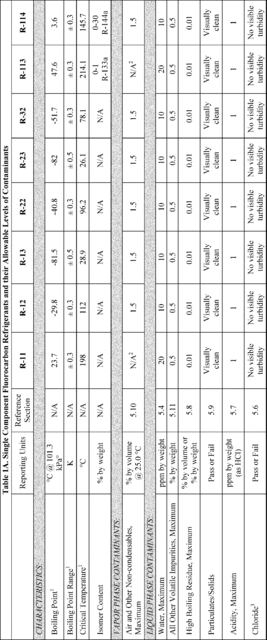
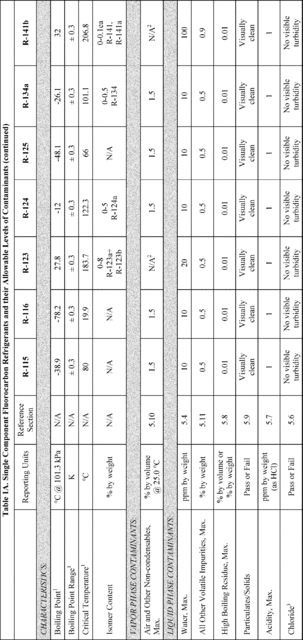
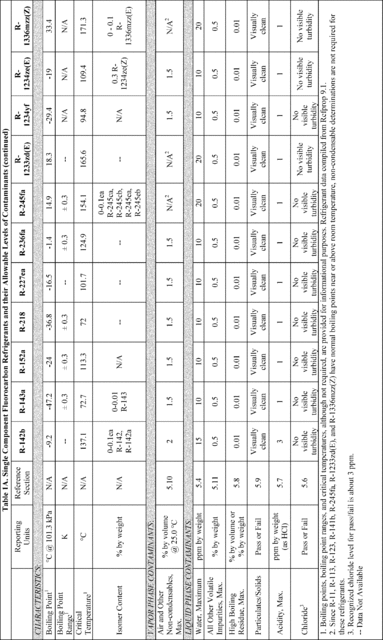

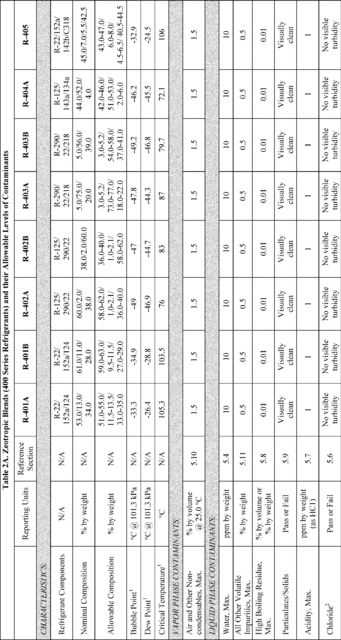
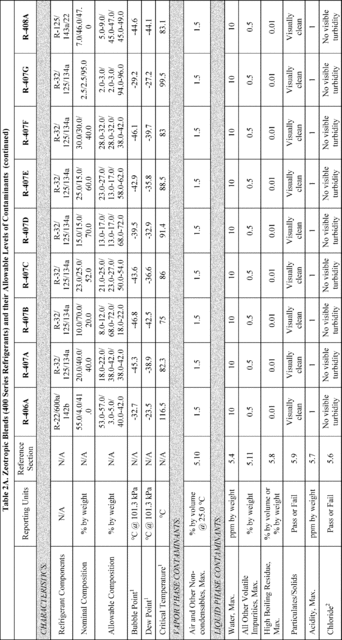
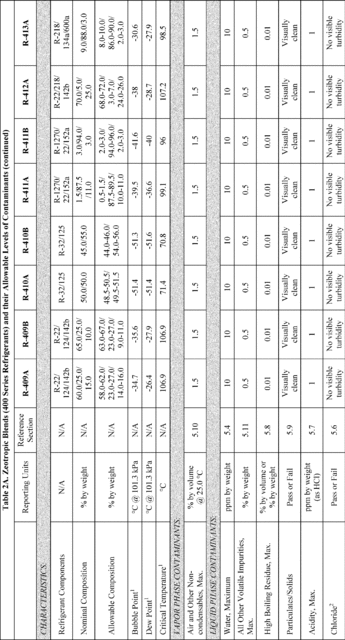
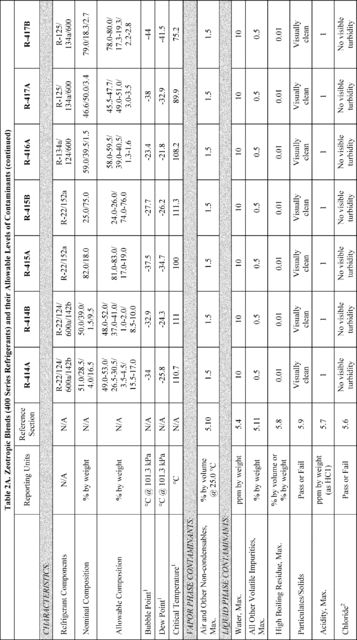
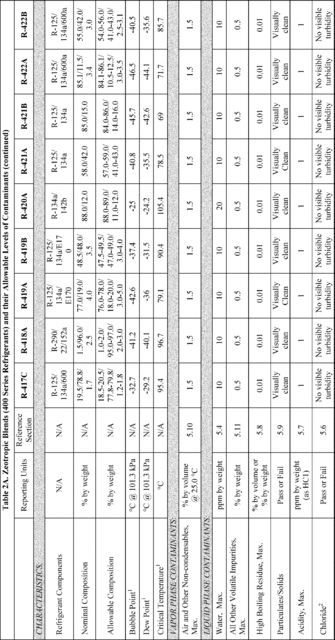
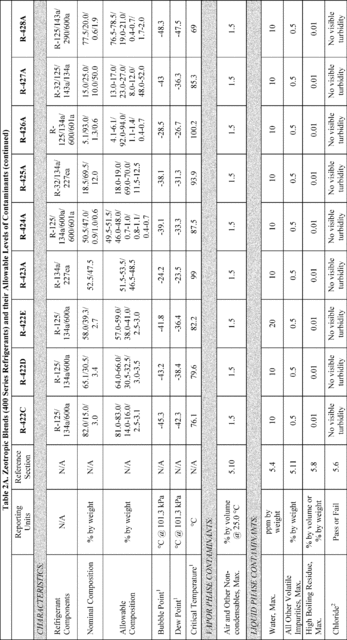
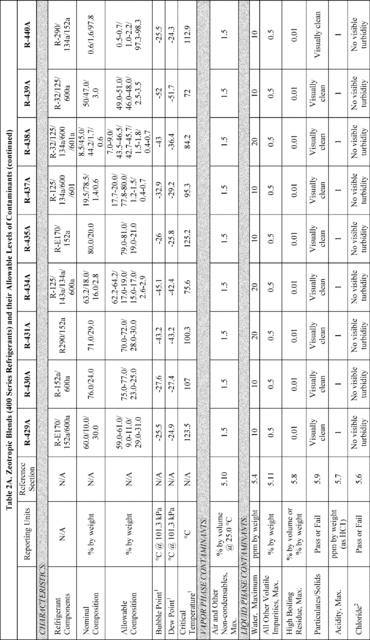

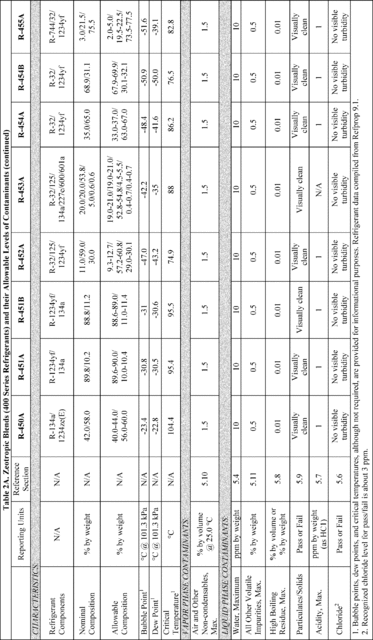
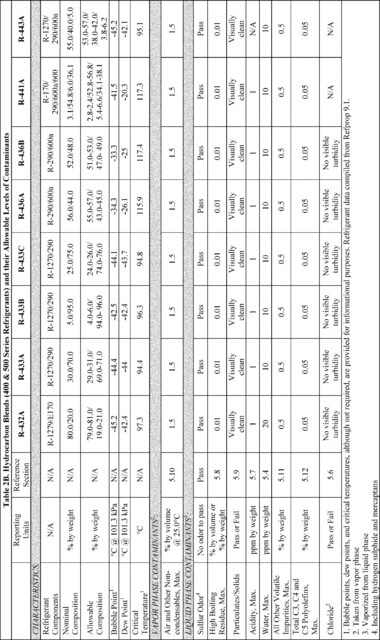
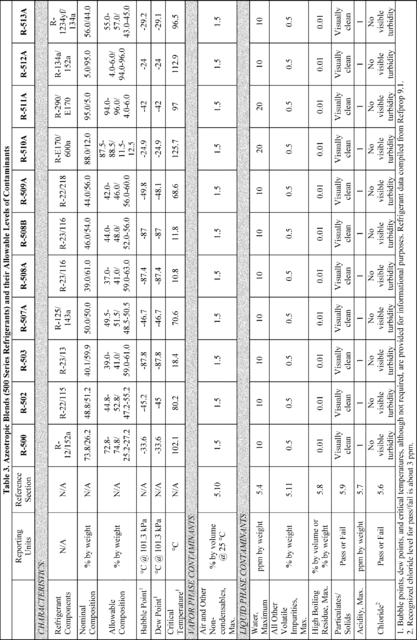 Section 7.0
References - Normative
Section 7.0
References - Normative
Listed here are all standards, handbooks, and other publications essential to the formation and implementation of the standard. All references in this appendix are considered as part of this standard.
ANSI/ASHRAE Standard 34-2013, Designation and Safety Classification of Refrigerants, with Addenda, American National Standards Institute/American Society of Heating, Refrigerating, and Air-Conditioning Engineers. 2008 Appendix C to AHRI Standard 700-2014, 2008 Appendix C for Analytical Procedures for AHRI Standard 700-2014 - Normative, copyright 2008 (incorporated by reference, see § 82.168). ASTM D1296-01 (Reapproved 2012), Standard Test Method for Odor of Volatile Solvents and Diluents, approved July 1, 2012, (incorporated by reference, see § 82.168). BB-F-1421B, Federal Specification for “Fluorocarbon Refrigerants,” dated March 5, 1982, (incorporated by reference, see § 82.168). GPA Standard 2177-13, Analysis of Natural Gas Liquid Mixtures Containing Nitrogen and Carbon Dioxide by Gas Chromatography, Revised, copyright 2013, (incorporated by reference, see § 82.168). REFPROP Reference Fluid Thermodynamic and Transport Properties NIST Standard Reference Database 23 version 9.1, 2013, U.S. Department of Commerce, Technology Administration, National Institute of Standards and Technology. Section 8.0 References - InformativeListed here are standards, handbooks, and other publications which may provide useful information and background but are not considered essential.
2012 Appendix D to AHRI Standard 700-2014, 2012 Appendix D for Gas Chromatograms for AHRI Standard 700-2014 - Informative, copyright 2012, (incorporated by reference, see § 82.168). {81 FR 82365, Nov. 18, 2016]Appendix A to Subpart G of Part 82 - Substitutes Subject to Use Restrictions and Unacceptable Substitutes
40:21.0.1.1.1.7.1.9.28 : Appendix A
Appendix A to Subpart G of Part 82 - Substitutes Subject to Use Restrictions and Unacceptable SubstitutesRefrigerants
Unacceptable Substitutes
| End-use | Substitute | Decision | Comments |
|---|---|---|---|
| CFC-11 centrifugal chillers (retrofit) | HCFC-141b | Unacceptable | Has a high ODP relative to other alternatives. |
| CFC-12 centrifugal chillers (retrofit) | HCFC-22/HFC-142b/CFC-12 | Unacceptable | As a blend of both Class I and Class II substances, it has a higher ODP than use of Class II substances. |
| Hydrocarbon blend A | Unacceptable | Flammability is a serious concern. Data have not been submitted to demonstrate it can used safely in this end-use. | |
| CFC-11, CFC-12, CFC-113, CFC-114, R-500 centrifugal chillers (new equipment/NIKs) | HCFC-22/HFC-142b/CFC-12 | Unacceptable | As a blend of both Class I and Class II substances, it has a higher ODP than use of Class II substances. |
| Hydrocabon blend A | Unacceptable | Flammability is a serious concern. Data have not been submitted to demonstrate it can be used safely in this end-use. | |
| HCFC-141b | Unacceptable | Has a high ODP relative to other alternatives. | |
| CFC-12 reciprocating chillers (retrofit) | HCFC-22/HFC-142b/CFC-12 | Unacceptable | As a blend of both Class I and Class II substances, it has a higher ODP than use of Class II substances. |
| Hydrocarbon blend A | Unacceptable | Flammability is a serious concern. Data have not been submitted to demonstrate it can be used safely in this end-use. | |
| CFC-12 reciprocating chillers (new equipment/NIKs) | HCFC-22/HFC-142b/CFC-12 | Unacceptable | As a blend of both Class I and Class II substances, it has a higher ODP than use of Class II substances. |
| Hydrocarbon blend A | Unacceptable | Flammability is a serious concern. Data have not been submitted to demonstrate it can be used safely in this end-use. | |
| CFC-11, CFC-12, R-502 industrial process refrigeration (retrofit) | HCFC-22/HFC-142b/CFC-12 | Unacceptable | As a blend of both Class I and Class II substances, it has a higher ODP than use of Class II substances. |
| CFC-11, CFC-12, R-502 industrial process refrigeration (new equipment/NIKs) | HCFC-22/HFC-142b/CFC-12 | Unacceptable | As a blend of both Class I and Class II substances, it has a higher ODP than use of Class II substances. |
| CFC-12, R-502 ice skating rinks (retrofit) | HCFC-22/HFC-142b/CFC-12 | Unacceptable | As a blend of both Class I and Class II substances, it has a higher ODP than use of Class II substances. |
| Hydrocarbon blend A | Unacceptable | Flammability is a serious concern. Data have not been submitted to demonstrate it can be used safely in this end-use. | |
| CFC-12, R-502 ice skating rinks (new equipment/NIKs) | HCFC-22/HFC-142b/CFC-12 | Unacceptable | As a blend of both Class I and Class II substances, it has a higher ODP than use of Class II substances. |
| Hydrocarbon blend A | Unacceptable | Flammability is a serious concern. Data have not been submitted to demonstrate it can be used safely in this end-use. | |
| CFC-12, R-502 cold storage warehouses (retrofit) | HCFC-22/HFC-142b/CFC-12 | Unacceptable | As a blend of both Class I and Class II substances, it has a higher ODP than use of Class II substances. |
| Hydrocarbon blend A | Unacceptable | Flammability is a serious concern. Data have not been submitted to demonstrate it can be used safely in this end-use. | |
| CFC-12, R-502 cold storage warehouses (new equipment/NIKs) | HCFC-22/HFC-142b/CFC-12 | Unacceptable | As a blend of both Class I and Class II substances, it has a higher ODP than use of Class II substances. |
| Hydrocarbon blend A | Unacceptable | Flammability is a serious concern. Data have not been submitted to demonstrate it can be used safely in this end-use. | |
| CFC-12, R-500, R-502 refrigerated transport (retrofit) | HCFC-22/HFC-142b/CFC-12 | Unacceptable | As a blend of both Class I and Class II substances, it has a higher ODP than use of Class II substances. |
| Hydrocarbon blend A | Unacceptable | Flammability is a serious concern. Data have not been submitted to demonstrate it can be used safely in this end-use. | |
| CFC-12, R-500, R-502 refrigerated transport (new equipment/NIKs) | HCFC-22/HFC-142b/CFC-12 | Unacceptable | As a blend of both Class I and Class II substances, it has a higher ODP than use of Class II substances. |
| Hydrocarbon blend A | Unacceptable | Flammability is a serious concern. Data have not been submitted to demonstrate it can be used safely in this end-use. | |
| CFC-12, R-502 retail food refrigeration (retrofit) | HCFC-22/HFC-142b/CFC-12 | Unacceptable | As a blend of both Class I and Class II substances, it has a higher ODP than use of Class II substances. |
| Hydrocarbon blend A | Unacceptable | Flammability is a serious concern. Data have not been submitted to demonstrate it can be used safely in this end-use. | |
| CFC-12, R-502 retail food refrigeration (new equipment/NIKs) | HCFC-22/HFC-142b/CFC-12 | Unacceptable | As a blend of both Class I and Class II substances, it has a higher ODP than use of Class II substances. |
| Hydrocarbon blend A | Unacceptable | Flammability is a serious concern. Data have not been submitted to demonstrate it can be used safely in this end-use. | |
| CFC-12, R-502 commercial ice machines (retrofit) | HCFC-22/HFC-142b/CFC-12 | Unacceptable | As a blend of both Class I and Class II substances, it has a higher ODP than use of Class II substances. |
| Hydrocarbon blend A | Unacceptable | Flammability is a serious concern. Data have not been submitted to demonstrate it can be used safely in this end-use. | |
| CFC-12, R-502 commercial ice machines (new equipment/NIKs) | HCFC-22/HFC-142b/CFC-12 | Unacceptable | As a blend of both Class I and Class II substances, it has a higher ODP than use of Class II substances. |
| Hydrocarbon blend A | Unacceptable | Flammability is a serious concern. Data have not been submitted to demonstrate it can be used safely in this end-use. | |
| CFC-12 vending machines (retrofit) | HCFC-22/HFC-142b/CFC-12 | Unacceptable | As a blend of both Class I and Class II substances, it has a higher ODP than use of Class II substances. |
| Hydrocarbon blend A | Unacceptable | Flammability is a serious concern. Data have not been submitted to demonstrate it can be used safely in this end-use. | |
| CFC-12 vending machines (new equipment/NIKs) | HCFC-22/HFC-142b/CFC-12 | Unacceptable | As a blend of both Class I and Class II substances, it has a higher ODP than use of Class II substances. |
| Hydrocarbon blend A | Unacceptable | Flammability is a serious concern. Data have not been submitted to demonstrate it can be used safely in this end-use. | |
| CFC-12, water coolers (retrofit) | HCFC-22/HFC-142b/CFC-12 | Unacceptable | As a blend of both Class I and Class II substances, it has a higher ODP than use of Class II substances. |
| Hydrocarbon blend A | Unacceptable | Flammability is a serious concern. Data have not been submitted to demonstrate it can be used safely in this end-use. | |
| CFC-12, water coolers (New equipment/NIKs) | HCFC-22/HFC-142b/CFC-12 | Unacceptable | As a blend of both Class I and Class II substances, it has a higher ODP than use of Class II substances. |
| Hydrocarbon blend A | Unacceptable | Flammability is a serious concern. Data have not been submitted to demonstrate it can be used safely in this end-use. | |
| CFC-12, household refrigerators (retrofit) | HCFC-22/HFC-142b/CFC-12 | Unacceptable | As a blend of both Class I and Class II substances, it has a higher ODP than use of Class II substances. |
| Hydrocarbon blend A | Unacceptable | Flammability is a serious concern. Data have not been submitted to demonstrate it can be used safely in this end-use. | |
| CFC-12, household refrigerators (new equipment/NIKs) | HCFC-22/HFC-142b/CFC-12 | Unacceptable | As a blend of both Class I and Class II substances, it has a higher ODP than use of Class II substances. |
| Hydrocarbon blend A | Unacceptable | Flammability is a serious concern. Data have not been submitted to demonstrate it can be used safely in this end-use. | |
| CFC-12, R-502 household freezers (retrofit) | HCFC-22/HFC-142b/CFC-12 | Unacceptable | As a blend of both Class I and Class II substances, it has a higher ODP than use of Class II substances. |
| Hydrocarbon blend A | Unacceptable | Flammability is a serious concern. Data have not been submitted to demonstrate it can be used safely in this end-use. | |
| CFC-12, 502 household freezers (new equipment/NIKs) | HCFC-22/HFC-142b/CFC-12 | Unacceptable | As a blend of both Class I and Class II substances, it has a higher ODP than use of Class II substances. |
| Hydrocarbon blend A | Unacceptable | Flammability is a serious concern. Data have not been submitted to demonstrate it can be used safely in this end-use. | |
| CFC-12, R-500 residential dehumidifiers (retrofit) | HCFC-22/HFC-142b/CFC-12 | Unacceptable | As a blend of both Class I and Class II substances, it has a higher ODP than use of Class II substances. |
| Hydrocarbon blend A | Unacceptable | Flammability is a serious concern. Data have not been submitted to demonstrate it can be used safely in this end-use. | |
| CFC-12, R-500 residential dehumidifiers (new equipment/NIKs) | HCFC-22/HFC-142b/CFC-12 | Unacceptable | As a blend of both Class I and Class II substances, it has a higher ODP than use of Class II substances. |
| Hydrocarbon blend A | Unacceptable | Flammability is a serious concern. Data have not been submitted to demonstrate it can be used safely in this end-use. | |
| CFC-12, motor vehicle air conditioners (retrofit) | HCFC-22/HFC-142b/CFC-12 | Unacceptable | As a blend of both Class I and Class II substances, it has a higher ODP than use of Class II substances. |
| Hydrocarbon blend A | Unacceptable | Flammability is a serious concern. Data have not been submitted to demonstrate it can be used safely in this end-use. | |
| CFC-12, motor vehicle air conditioners (new equipment/NIKs) | HCFC-22/HFC-142b/CFC-12 | Unacceptable | As a blend of both Class I and Class II substances, it has a higher ODP than use of Class II substances. |
| Hydrocarbon blend A | Unacceptable | Flammability is a serious concern. Data have not been submitted to demonstrate it can be sued safely in this end-use. |
Foams
Unacceptable Substitutes
| End-use | Substitute | Decision | Comments |
|---|---|---|---|
| CFC-11 Polyolefin | HCFC-141b (or blends thereof) | Unacceptable | HCFC-141b has an ODP of 0.11, almost equivalent to that of methyl chloroform, a Class I substance. The Agency believes that non-ODP alternatives are sufficiently available to render the use of HCFC-141b unnecessary in polyolefin foams. |
Substitutes Acceptable Subject to Narrowed Use Limits
| End-use | Substitute | Decision | Comments |
|---|---|---|---|
| Electronics cleaning w/CFC-113, MCF | Perfluoro-carbons (C5F12, C6F12, C6F14, C7F16, C8F18, C5F11NO, C6F13NO, C7F15NO, and C8F16) | Acceptable for high-performance, precision-engineered applications only where reasonable efforts have been made to ascertain that other alternatives are not technically feasible due to performance or safety requirements | The principal environmental
characteristic of concern for PFCs is that they have long
atmospheric lifetimes and high global warming potentials. Although
actual contributions to global warming depend upon the quantities
of PFCs emitted, the effects are for practical purposes
irreversible. Users must observe this limitation on PFC acceptability by conducting a reasonable evaluation of other substitutes to determine that PFC use is necessary to meet performance or safety requirements. Documentation of this evaluation must be kept on file. For additional guidance regarding applications in which PFCs may be appropriate, users should consult the Preamble for this rulemaking. |
| Precision cleaning w/CFC-113, MCF | Perfluoro-carbons (C5F12, C6F12, C6F14, C7F16, C8F18, C5F11NO, C6F13NO, C7F15NO, and C8F16) | Acceptable for high-performance, precision-engineered applications only where reasonable efforts have been made to ascertain that other alternatives are not technically feasible due to performance or safety requirements | The principal environmental
characteristic of concern for PFCs is that they have long
atmospheric lifetimes and high global warming potentials. Although
actual contributions to global warming depend upon the quantities
of PFCs emitted, the effects are for practical purposes
irreversible. Users must observe this limitation on PFC acceptability by conducting a reasonable evaluation of other substitutes to determine that PFC use is necessary to meet performance or safety requirements. Documentation of this evaluation must be kept on file. For additional guidance regarding applications in which PFCs may be appropriate, users should consult the Preamble for this rulemaking. |
Unacceptable Substitutes
| End-use | Substitute | Decision | Comments |
|---|---|---|---|
| Metals cleaning w/CFC-113 | HCFC 141b and its blends | Unacceptable | High ODP; other alternatives exist. Effective date: As of 30 days after final rule for uses in new equipment (including retrofits made after the effective date); as of January 1, 1996, for uses in existing equipment. EPA will grant, if necessary, narrowed use acceptability listings for CFC-113 past the effective date of the prohibition. |
| Metals cleaning w/MCF | HCFC 141b and its blends | Unacceptable | High ODP; other alternatives exist. Effective date: As of 30 days after final rule for uses in new equipment (including retrofits made after the effective date); as of January 1, 1996, for uses in existing equipment. |
| Electronics cleaning w/CFC-113 | HCFC 141b and its blends | Unacceptable | High ODP; other alternatives exist. Effective date: As of 30 days after final rule for uses in new equipment (including retrofits made after the effective date); as of January 1, 1996, for uses in existing equipment. EPA will grant, if necessary, narrowed use acceptability listings for CFC-113 past the effective date of the prohibition. |
| Electronics cleaning w/MCF | HCFC 141b and its blends | Unacceptable | High ODP; other alternatives exist. Effective date: As of 30 days after final rule for uses in new equipment (including retrofits made after the effective date); as of January 1, 1996, for uses in existing equipment. |
| Precision cleaning w/CFC-113 | HCFC 141b and its blends | Unacceptable | High ODP; other alternatives exist. Effective date: As of 30 days after final rule for uses in new equipment (including retrofits made after the effective date); as of January 1, 1996, for uses in existing equipment. EPA will grant, if necessary, narrowed use acceptability listings for CFC-113 past the effective date of the prohibition. |
| Precision cleaning w/MCF | HCFC 141b and its blends | Unacceptable | High ODP; other alternatives exist. Effective date: As of 30 days after final rule for uses in new equipment (including retrofits made after the effective date); as of January 1, 1996, for uses in existing equipment. |
Fire Suppression and Explosion Protection Streaming Agents
Substitutes Acceptable Subject to Narrowed Use Limits
| End-use | Substitute | Decision | Conditions | Comments |
|---|---|---|---|---|
| Halon 1211 Streaming Agents | [CFC Blend] | Acceptable in nonresidential uses only | Use of CFCs are controlled under CAA section 610 which bans use of CFCs in pressurized dispensers, and therefore are not permitted for use in portable fire extinguishers. EPA will list this agent as proposed unacceptable in the next SNAP proposed rulemaking. | |
| Because CFCs are a Class I substance, production will be phased out by January 1, 1996. | ||||
| See additional comments 1, 2. | ||||
| HBFC-22B1 | Acceptable in nonresidential uses only | Proper procedures regarding the operation of the extinguisher and ventilation following dispensing the extinguishant is recommended. Worker exposure may be a concern in small office areas. | ||
| HBFC-22B1 is considered an interim substitute for Halon 1211. Because the HBFC-22B1 has an ODP of .74, production will be phased out (except for essential uses) on January 1, 1996. | ||||
| This agent was submitted to the Agency as a Premanufacture Notice (PMN) and is presently subject to requirements contained in a Toxic Substance Control Act (TSCA) Consent Order. | ||||
| See additional comments 1, 2. | ||||
| C6 F14 | Acceptable for nonresidential uses where other alternatives are not technically feasible due to performance or safety requirements: | Users must observe the
limitations on PFC acceptability by making reasonable effort to
undertake the following measures: (i) conduct an evaluation of foreseeable conditions of end use; (ii) determine that the physical or chemical properties or other technical constraints of the other available agents preclude their use; and |
||
| a. due to the physical or chemical properties of the agent, or | (iii) determine that human
exposure to the other alternative extinguishing agents may approach
or result in cardiosensitization or other unacceptable toxicity
effects under normal operating conditions; Documentation of such measures must be available for review upon request. |
|||
| b. where human exposure to the extinguishing agent may approach cardiosensitization levels or result in other unacceptable health effects under normal operating conditions | The principal environmental
characteristic of concern for PFCs is that they have high GWPs and
long atmospheric lifetimes. Actual contributions to global warming
depend upon the quantities of PFCs emitted. For additional guidance regarding applications in which PFCs may be appropriate, users should consult the description of potential uses which is included in the preamble to this rulemaking. |
|||
| See additional comments 1, 2. |
Additional Comments:
1 - Discharge testing and training should be strictly limited only to that which is essential to meet safety or performance requirements.
2 - The agent should be recovered from the fire protection system in conjunction with testing or servicing, and recycled for later use or destroyed.
Fire Suppression and Explosion Protection Streaming Agents
Unacceptable Substitutes
| End-use | Substitute | Decision | Comments |
|---|---|---|---|
| Halon 1211 Streaming Agents | [CFC-11] | Unacceptable | This agent has been suggested for use on large outdoor fires for which non-ozone depleting alternatives are currently used. |